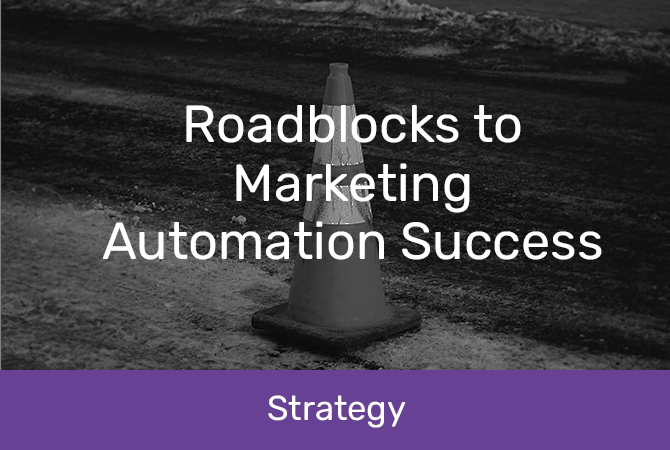Roadblocks to full-scale marketing automation
Is your automation tech falling flat? Here’s what could be happening.
Automation has been the marketing tech buzzword for the past few years. Promising to drive sales, save time, reduce human error and improve the customer experience, it sounds like a dream come true for harried CMOs. Using terms like ‘seamless’ and ‘turn-key integration’, many vendors sell the tech on simplicity and ease of use, implying that it should slot into your current stack with little to no effort.
Unfortunately, as with any tech upgrade, it’s not always as simple as it seems. Marketing automation can deliver powerful results, but it might not work right away. For many businesses, internal roadblocks and hidden friction points can limit the potential benefits of automation, making it harder to get a return on their investment.
The first step toward smoothing the path is identifying those pain points – here’s a look at some of the most common:
Data isn’t surfaced where it’s needed
Improving customer experiences and boosting sales is all about data. Done well, your automation stack should be able to pull data at set touchpoints along the customer journey, delivering a consistent, seamless experience for every customer.
But no matter how much capability is built into your automation platform, it will only ever be as good as the data feeding into it. Businesses tend to underinvest and undervalue this piece of the puzzle – often because software vendors underplay its importance.
If your systems aren’t surfacing the right data in the right format at the right time, delivering that seamless, streamlined customer experience is near impossible. Great tech can be hampered by a lack of access to data from other systems or manual functions slowing down key processes. For example, if your sales system, CRM and marketing platforms don’t link up, it’s tricky to follow up with customers after a sale.
Before achieving automation at scale, you need to sort out the internal workings of your data. Often, your IT team won’t be right for the job – they might be too busy, may not have the skills needed or may not think like marketers.
Internal capacity doesn’t match demand
Tech is all well and good, but you also need people to keep it humming. In a market with a talent shortage and high staff turnover, it can be hard to build the capacity to maximise the value of your tech and provide continuity. You don’t want everything to fall apart just because one person decides to move on.
Although there’s not much you can do about staff leaving, you can focus on building a strong automation team, ensure you have multiple people able to manage and troubleshoot your tech, and create training and onboarding processes so new people can get up to speed quickly.
This is where a partnership support model can deliver incredible value. Working with a third-party expert that can fill in the tech gaps, no matter what’s happening with your staff, helps you maintain consistency and avoid internal capacity issues.
It’s not just what you do – it’s how you do it
Marketing automation is often sold with a promise of instant efficiency – we’re here to tell you that it’s (sadly) not quite that easy. If your business has relied on fragile data pipelines and manual tasks, introducing ultra-efficient new tech won’t immediately change those systems. Tech efficiency must be supported by new, efficient processes and ‘ways of working’ in your business.
Use the tech as a springboard to boost efficiency rather than expecting it to transform your business all on its own. You may need to rework some key processes, identify roadblocks or bottlenecks that slow results, or start from scratch to ensure all your workflows, well, work.
Don’t stop improving
Are your sales and marketing processes set in concrete, or are you constantly looking for ways to improve? If you don’t have a culture of continual improvement in your business, you’re probably not making the most of your marketing tech.
Continual improvement means having a disciplined framework in which staff are encouraged – and given time – to look for inefficiencies and test new ideas. They should connect these new ideas to wider marketing goals and metrics. Keep it light at first – test at a low level, rather than rolling out unproven campaign strategies - then take the time to automate. Even if you think your systems are working at full capacity, there’s always a small tweak that could make a big difference.
Complexity is hard to scale
Start simple and lightweight, and it’s far easier to scale up. Start with a big, multi-layered campaign, and you might find it difficult to roll out to all your customers.
The trick is focusing on speed and efficiency from the start. For example, you could deploy a win-back campaign to target individual customers at risk of leaving. If you build a complex journey with multiple touchpoints and customer interactions, it may work beautifully for a small sample of your customers – but it will be difficult to scale as customer numbers increase. Light and nimble is almost always the way to go.
What’s getting in the way of your automation tech?
Not getting the results you want from your marketing automation investment? You’re not alone – many businesses struggle to get the value they want from new marketing tech. While there’s no single solution, it starts with focusing on problem areas and picking the right partners to help you sort out the mess.
That’s where Datamine comes in. We offer an expert eye to help you figure out what’s happening in your business, and we can sort out the underlying problems as well.
We’re always talking about making the most of marketing automation – take a look at our monthly article series for more insights.
If you’re missing automation opportunities, talk to the Datamine team now.
















































